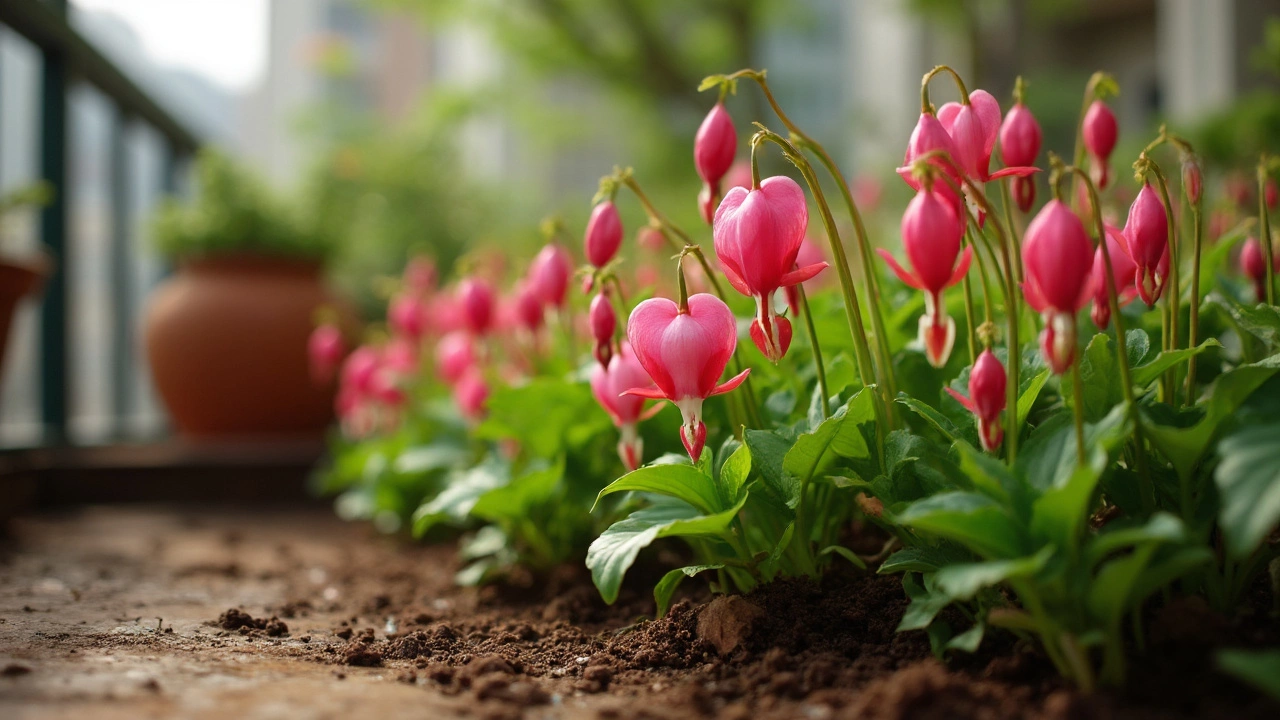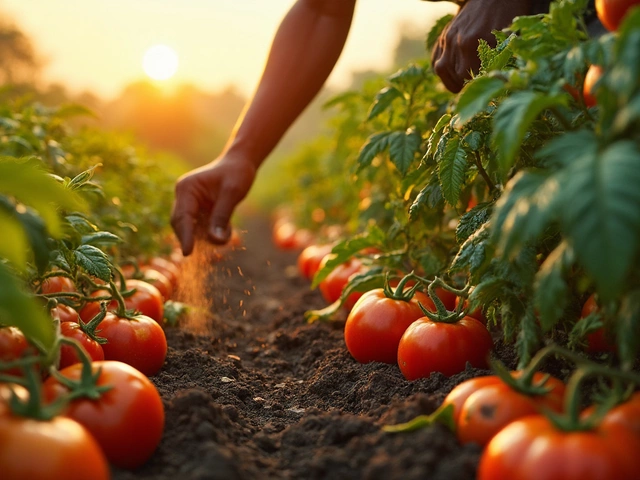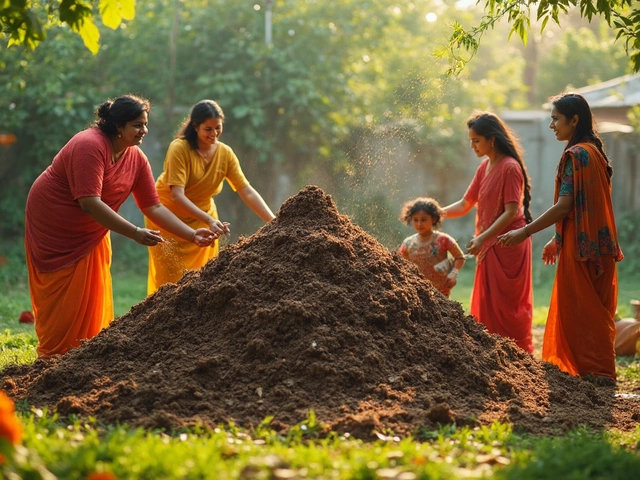Ever brewed a pot of coffee and wondered if those leftover grounds could help your bleeding hearts bloom better? You’re not alone; loads of folks have tried tossing coffee grounds onto their garden beds, hoping for lush, happy plants. But does it actually work for bleeding hearts, or are you better off composting those grounds instead?
If you want your bleeding hearts to come back strong every spring and put out those puffy pink “hearts,” your soil and feeding habits matter a lot. Bleeding hearts like their soil moist, slightly acidic, and full of rich organic stuff. Coffee grounds, which are just the remains from your favorite cup of joe, sound like they could fit the bill—but there are a few things you need to know before dumping them straight onto your perennials.
- What Bleeding Hearts Need to Grow
- The Truth About Coffee Grounds in the Garden
- Pros and Cons for Bleeding Hearts
- Smart Ways to Use Coffee Waste
- Other Easy Hacks for Happy Bleeding Hearts
What Bleeding Hearts Need to Grow
If you want big, healthy bleeding hearts, the right setup is key. These are shade-loving plants, so if your spot gets blasted by direct sun all afternoon, they’ll probably sulk. Aim for filtered light, like under a leafy tree or somewhere morning sun is followed by shade the rest of the day. If you’ve got heavy clay or rocky soil in your garden, it’s worth a little work to get things just right for them.
Soil is a big deal. Bleeding hearts like soil that drains well but doesn’t dry out—think soft, crumbly, and a little moist, kind of like a chocolate cake mix. They don’t want their roots sitting in puddles, but they’re not fans of bone-dry dirt either. For pH, they prefer soil that’s slightly on the acidic side, somewhere around 6.0 to 6.5. If you don’t know your soil’s pH, kits from garden centers make it easy to check.
Don’t forget the organic matter. Mixing in compost or leaf mold helps hold moisture while feeding your plant at the same time. It also keeps the soil loose, so roots can spread out without a fight. If you notice your bleeding heart leaves turning yellow, you might be dealing with either too much sun or not enough nutrients in the soil—a solid sign it’s time to add compost or mulch.
Bleeding hearts don’t like to be crowded. Give them space, about a foot and a half apart, so air can move through and keep fungus problems down. Water regularly, especially during dry spells, but skip the overhead sprinklers—wet leaves are a recipe for disease. Always water the base of the plant instead.
- Partial to full shade is best.
- Keep the soil moist but not soggy.
- Add compost or natural mulch every spring for top results.
- Good drainage matters to prevent root rot.
- Test for slightly acid soil if you want happy plants.
The Truth About Coffee Grounds in the Garden
Coffee grounds have a big rep in the gardening world. People talk about them like garden gold, but do they really help, or is it just hype? Here’s what’s actually going on when you use coffee grounds in your yard.
First, coffee grounds are a byproduct of brewing coffee—they’re not magic fertilizer. They do add some nutrients like nitrogen, a bit of potassium, magnesium, and calcium. But it’s not a fertilizer substitute by any means. When you dump a pile of grounds on the soil, they’re pretty acidic. Over time though, when mixed into compost, their pH balances out and becomes more neutral.
This leads to a big point: fresh coffee grounds can make your soil more acidic. That works for acid-loving plants, but too much can mess with the balance for others. A bleeding heart likes its soil slightly acidic, but not overly so. Straight-up grounds could make things too harsh. Another fact—used coffee grounds have way less caffeine and acidity than fresh, which is better for most garden uses.
If you look at research, the main benefits come out when coffee grounds are mixed with other compost ingredients. Tossing them directly onto the soil in thick layers can actually make the dirt crusty and block water from getting in. Not ideal for most plants, and definitely not for bleeding hearts that like moisture.
| Coffee Grounds Stat | Why It Matters |
|---|---|
| Nitrogen (%) | About 2.1%—adds a small boost for compost |
| Potassium (%) | About 0.3%—helps with blooming, but not a game-changer |
| pH (used grounds) | Between 6.5-6.8—pretty safe, yet too much can nudge soil more acidic |
| Compost benefit | Keeps worms happy, helps break down scraps |
So, using coffee grounds in your garden soil does have some perks, but it’s not a magic fix. Mix them into compost or use thin layers as a light mulch—never thick. That’s the safest way to get the benefits without overdoing it.

Pros and Cons for Bleeding Hearts
So, should you really use coffee grounds on your bleeding hearts? Let’s break it down so you don’t have to experiment blindly.
Pros:
- Slight boost of acidity: Bleeding hearts prefer soil that’s a little on the acidic side, and fresh coffee grounds can lower the pH a bit if your dirt is too alkaline. But don’t expect miracles; the effect is mild.
- Adds organic matter: Those old coffee grounds mix right into your soil, making it a bit fluffier and easier for roots to stretch out. That helps with drainage and keeps soil from getting packed tight.
- Worm magnet: Earthworms really like coffee grounds. When you toss them in, you’re basically setting out a buffet for worms, and more worms usually means healthier, richer soil.
Cons:
- Not a fertilizer: Coffee grounds aren’t magic plant food. They have some nitrogen, but not enough to replace regular fertilizer, especially for hungry perennials like bleeding hearts.
- Can mat and block water: If you pile on the grounds too thick, they can stick together and form a crust. That crust keeps water from soaking into the soil, which is the last thing bleeding hearts want.
- Not always pH friendly: Used coffee grounds aren’t super acidic. In fact, after brewing, most of the acid is gone. So if your soil is already at a good pH, you won’t see a huge change—and adding too much could even turn soil a little too acidic over time.
- Mold and pests: Thick layers of coffee grounds can attract mold, which is ugly and can sometimes bother your plants. Every now and then, pests like gnats can show up, too.
Bottom line? Coffee grounds have some perks, but you’ve gotta use them right. A thin sprinkle in your garden bed or mixed into your compost is usually the way to go, rather than piling them up around your bleeding hearts.
Smart Ways to Use Coffee Waste
Here’s the deal—coffee waste can be a goldmine for your kitchen garden, but only if you use it the right way. Tossing fresh coffee grounds right on top of your bleeding hearts isn’t the smartest move. Fresh grounds can make the soil too acidic, and they can clump together, blocking water and air. But that doesn’t mean you have to toss them in the trash. There are smarter ways to put that coffee waste to work.
- Mix used coffee grounds into your compost pile. This gives them a chance to break down and mellow out. By the time you add your finished compost around your bleeding hearts, there’s no risk of it being too acidic.
- Sprinkle a thin layer of fully dried, used grounds around the base of your plants. Stick to less than half an inch. Any more, and you could block water or attract mold.
- Combine grounds with brown materials like dead leaves or shredded paper before adding to the soil. This keeps your compost balance on track and helps break it all down evenly.
- Try making a "coffee tea" for plants—soak a cup of used grounds in a gallon of water for a day or two, then use the water for watering. It adds a gentle nutrient boost without piling up solids.
Worried coffee grounds might pile up and do more harm than good? Just check out the data below. Used correctly, coffee grounds have mild benefits and almost no downside for garden soil when balanced with other materials.
| How to Use Coffee Grounds | Possible Effects | Notes |
|---|---|---|
| Directly on soil (fresh) | Raises acidity, may block water | Risky for bleeding hearts |
| Composted | Improves soil structure, adds nitrogen | Best and safest method |
| In coffee "tea" | Gentle nutrient boost | Less risk of buildup |
| Thin layer as mulch | Retains moisture, deters pests | Keep layer thin |
So, don’t dump your grounds and hope for the best—be smart about it. Compost them, blend with brown materials, or try liquid feeding. Your kitchen waste gets recycled, your bleeding hearts stay happy, and Fluffy—my cat—won't be tempted to dig around in sour-smelling dirt.

Other Easy Hacks for Happy Bleeding Hearts
If you want your bleeding hearts to look amazing all season, there are a handful of solid tricks that really work. These aren’t complicated, and you can do most of them even if you only have a tiny garden or just a couple of pots.
- Mulch is your best friend. Use shredded leaves, straw, or wood chips (the chunky kind, not sawdust) to keep soil cool and moist. This also cuts down on weeds. Bleeding hearts hate dry roots, so mulch helps them stay perky, especially in hot summers.
- Don’t let plants get crowded. These guys can get powdery mildew or rot if there’s not enough air moving around the leaves. If you’re planting a few together, space them at least a foot apart.
- Snip off dead flowers and yellowing leaves. In garden speak, that’s called deadheading. It keeps the plant tidy and sometimes even triggers a bonus bloom. Plus, it cuts down on bugs.
- Water smart. Give the soil a good soak when the top inch dries out, but don’t keep things swampy. Bleeding hearts wilt fast in soggy dirt.
- Add organic matter every spring. Simple: dump a spade of compost or old manure on top of the soil. No need to dig—just let rain and critters pull it down.
- If you live somewhere scorching, shade is a must. Bleeding hearts fade fast in full sun. Partial shade, like under trees or next to your house, is ideal.
Want some real numbers? Here’s a quick cheat sheet on what bleeding hearts actually need for top growth:
| Condition | What Works Best |
|---|---|
| Soil pH | 6.0 - 6.5 |
| Hours of Shade | 4-6 daily |
| Water | Once/twice a week in dry spells |
| Spacing | 12-18 inches apart |
| Best Mulch Depth | 2-3 inches |
No need to overthink it. Regular mulch, a bit of space, some cool shade, and steady watering go a long way for bleeding hearts. And honestly, even if you forget fertilizer, a top-up of compost usually does the trick better than anything from a box. If Fluffy, my cat, doesn't paw at your mulch or dig up your shade-loving flowers, you’re probably doing it right.




